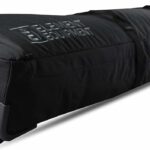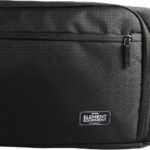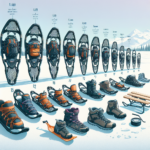Picking up the perfect snowboard can feel like an intricate hunt when you’re not sure about the right size to go for. “How Big Are Snowboards?” is just the right guide you need to navigate this unfamiliar territory, ensuring you don’t end up with a board that’s off-kilter for your specific needs. Filled with crucial information on dimension standards, sizing considerations and tips to make the selection easier, this article becomes your go-to manual, helping you understand the size spectrum of this popular equipment. Let’s help you find a snowboard that compliments your style, skill level, and physique perfectly.
Understanding Snowboard Sizing
When you’re off to hit the slopes, having the right snowboard can make all the difference. One of the most important considerations when choosing a snowboard is its size. Selecting a snowboard that matches your body build and riding style not only enhances your performance but also contributes to your safety.
The Importance of Choosing the Right Size
The size of your snowboard impacts how well you can control it, how stable you feel when you’re on it, and how the board performs overall. Boards that are too long can be hard to control, while those that are too short might not provide the stability you need, particularly at high speeds. Therefore, you need to make sure that such a crucial piece of gear like your snowboard is the right size for you.
Factors That Influence Snowboard Size
Several factors come into play while selecting the right snowboard size. These factors include your weight, height, foot size, and your riding style. There’s no one-size-fits-all in snowboarding, and each of these factors needs to be considered to help you find a snowboard size that will maximize your performance on the snow.
Common Snowboard Sizes
Snowboard sizes can vary significantly, depending on the age and ability level of the rider.
Typical Sizes for Children
For children just starting out in snowboarding, a shorter board is usually recommended as it’s easier to maneuver and control. Children’s snowboards typically range from 90cm to 130cm in length.
Typical Sizes for Adults
Adult snowboard sizes, on the other hand, accommodate a much wider range, generally starting from about 140cm and going up to 170cm or more. Remember that the ideal board length for adults depends greatly on weight, height, and skill level.
How Rider’s Weight Influences Snowboard Size
Weight is one of the most crucial factors to consider when choosing a snowboard size.
How Weight Impacts Performance
The reason your weight plays such a significant role in snowboard sizing is straightforward: it affects how the snowboard reacts to your movements. Heavier riders will need a longer board to help distribute their weight over a larger surface area, making the board more stable and easier to control.
Recommended Snowboard Sizes Based on Weight
Most manufacturers provide a weight range for each of their snowboard models. This makes it easier for riders to find a board that’s sized appropriately for their weight. Make sure to check these weight charts when you’re in the market for a new snowboard.
Length of Snowboards
The number you most often see associated with a snowboard’s size is its length, but it’s not just about height matching.
Average Length of Snowboards for Different Skill Levels
Beginner riders might prefer shorter boards as they’re easier to control, while more advanced snowboarders usually go for longer boards that provide better stability at high speeds. Generally, the length of the snowboard is measured from nose to tail and expressed in centimeters.
How Length Affects Ride and Control
Snowboard length plays a critical role in your control over the board. A longer board will provide increased stability and control, particularly at higher speeds and in rough conditions. Meanwhile, a shorter board is easier to maneuver and is usually preferable for tricks and park riding.
Width of Snowboards
Next to length, the width of your snowboard is a significant consideration, particularly for those with larger feet.
Average Width of Snowboards
Snowboards generally come in either regular or wide widths. Regular-width boards are typically ideal for riders with boot sizes of US 10 (UK 9) and under, while those with larger boot sizes should consider wide-width boards.
How Width affects Balance and Stokes
The width of a snowboard affects how well it handles turns and how much the rider’s feet hang over the edges of the board. A board that is too narrow may cause your feet to hang off the sides, which can cause balance issues and affect your control while turning.
Different Styles of Snowboards and Their Sizes
Snowboard styles can be generally categorized as freestyle, all-mountain, and powder.
Sizes of Freestyle Snowboards
Freestyle snowboards are usually shorter, with softer flex to allow for maneuvers and tricks. Riders who prefer park and pipe riding or those who love hitting jumps and rails should opt for freestyle snowboards.
Sizes of All-Mountain Snowboards
All-mountain snowboards are very versatile and are designed to handle almost any terrain or conditions. They are typically longer than freestyle boards, providing excellent control and stability.
Sizes of Powder Snowboards
Powder boards are designed specifically for deep snow conditions. They are usually longer and wider, which helps them float on top of the snow and provides a smooth ride in powder snow.
Gender and Snowboard Size
Differences in Snowboard Size for Men and Women
Snowboards are designed differently for men and women, mainly due to the differences in body shapes and sizes. Women’s snowboards are typically narrower, lighter, and have a softer flex, which caters to the average woman’s lighter weight and smaller foot size.
Impact of Rider’s Gender on Snowboard Size Choice
The gender of the rider can greatly impact the overall size and shape of the snowboard. It’s crucial for a rider to choose a board designed for their gender to ensure the best fit, performance, and comfort on the slopes.
How Age and Growing Child Affects Snowboard Size
Snowboard Size Adjustments for Growing Kids
As children grow and their snowboarding skills develop, their snowboard size will need to be adjusted. As kids get taller and heavier, they will need to move up to a larger board.
When to Upsize Your Child’s Snowboard
It’s time to upsize your child’s snowboard when it no longer supports their weight or when they find it hard to control their current board. It’s also advisable to size up if their skills and confidence on the board have noticeably increased.
Beginner’s Guide to Choosing Snowboard Size
Steps to Finding the Perfect Snowboard Size
To find the perfect snowboard size, start by considering your weight, height, and boot size. Next, think about your skill level and preferred riding style. Once you have that information, use the manufacturer’s size charts as a guide.
Common Mistakes in Choosing Snowboard Size
Common mistakes when choosing a snowboard size include focusing on the rider’s height instead of weight, neglecting to account for boot size which could lead to toe or heel drag, and not taking into account the type of snowboarding they plan to do.
Impact of Boot Size on Snowboard Size
Why Boot Size Matters
Your boot size matters when choosing a snowboard size because it impacts how well your feet fit on the board. Your boots shouldn’t hang too far off the board’s edges, as this can cause you to lose balance and control when making turns.
Finding a Snowboard That Matches Your Boot Size
Look closely at the snowboard’s width to ensure it matches your boot size. If you have a larger boot size, you may need to opt for a wider board to prevent heel or toe drag.
Wrapping up, getting the correct snowboard size depends heavily on personal factors and preferences. Remember, a properly sized board will react and perform in sync with your own movements, significantly improving your overall snowboarding experience. So, take your time and choose wisely.
- What Snowboard Bindings Should I Get? - January 23, 2024
- What Size Screws For Snowboard Bindings? - January 23, 2024
- How To Snowmobile On Water? - January 23, 2024









